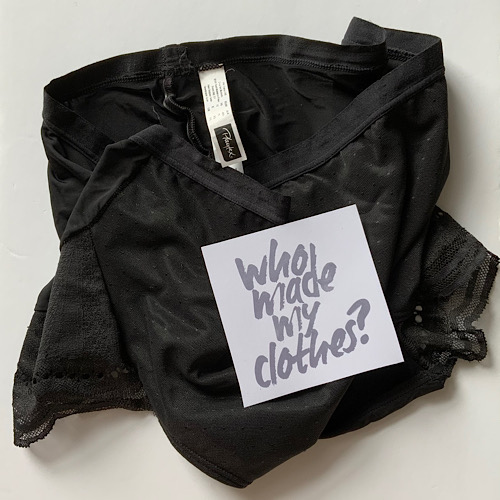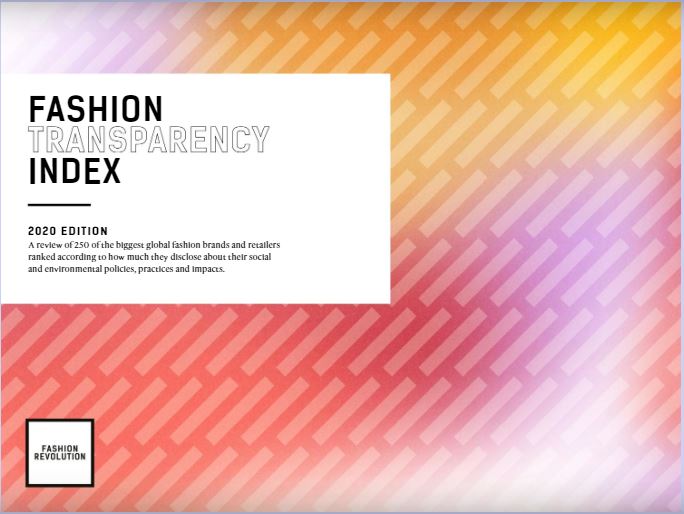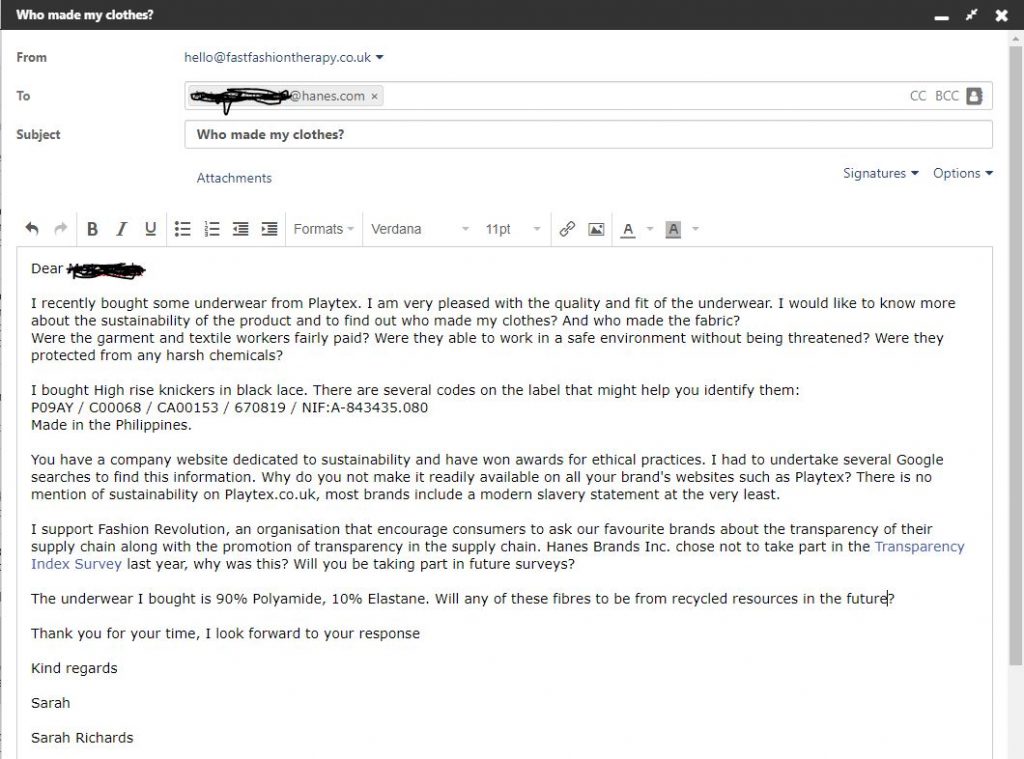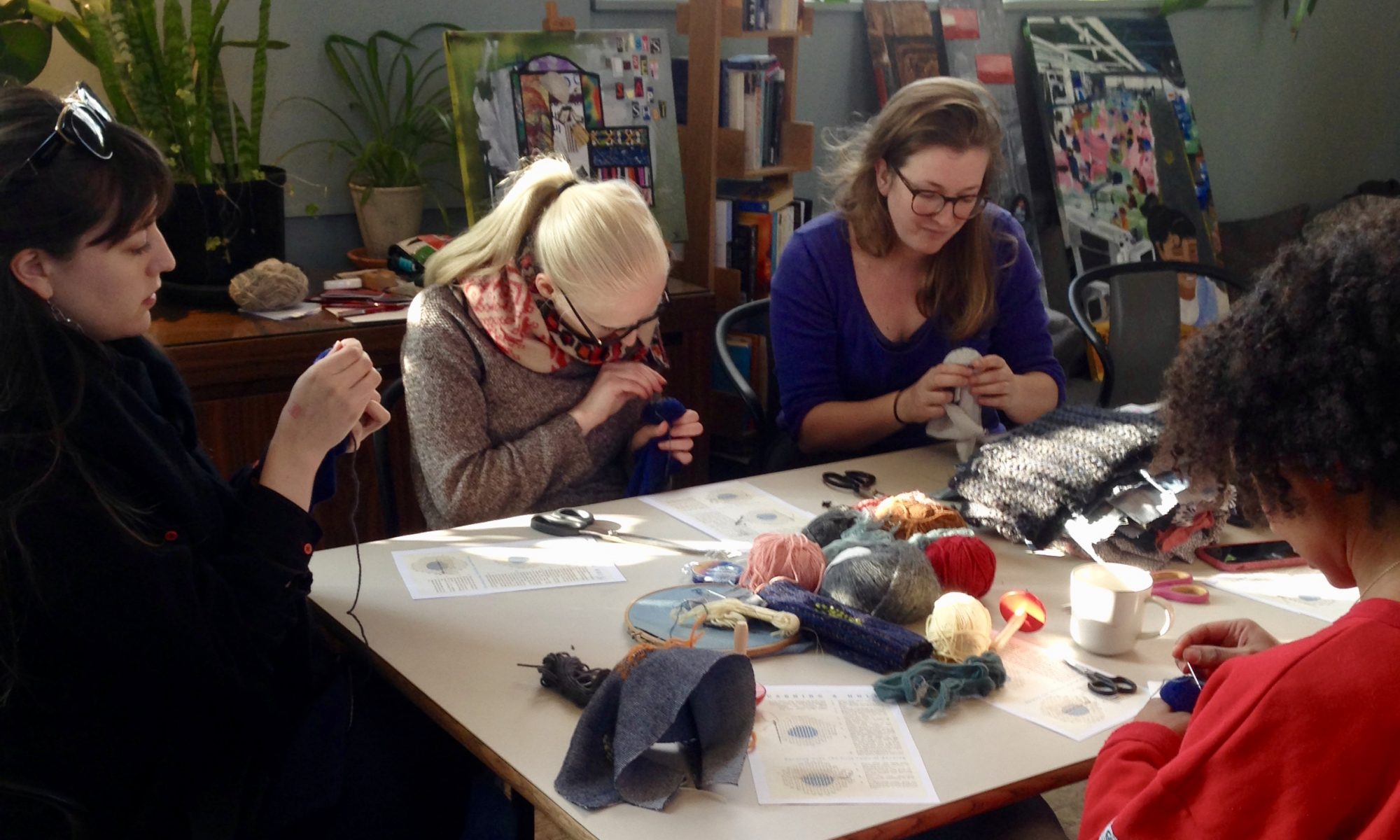
At Fast Fashion Therapy we teach and encourage people to mend their clothes and buy second hand as a sustainable alternative to buying new products. We live by our values and rarely buy anything new. So when it comes to asking our favourite brands who made my clothes, we struggle. One item of clothing that is trickier to buy second hand is underwear and I have bought new products within the last 12 months. We tasked the brands we bought from to encourage transparency within their supply chain. Of course, it doesn’t matter how old your garment is or whether it is second hand, it is still relevant to ask the brand #whomademyclothes? For the purposes of this blog it was easier to use a new item of clothing so the brand could track it’s supply chain. Here is how we got on:
Online information
What can you find out from the brand’s website? Don’t just look at the product pages and the brand’s advertising campaigns. Drop down to the bottom of the page and check out their corporate information. I chose a pair of knickers from Playtex’s current range and found out:
- My underwear is 90% Polymide and 10% Elastane. Polymide is a form of Polyester, it is plastic and damaging to the planet. Could Playtex source a recycle form of Polyester? Elastane is a form of elastic – is it from a natural sustainable source or derived from petrol-chemicals like Polyester?
- The label says the underwear was made in the Philippines, do Playtex own the factory? Do they run regular audits to ensure there is no modern slavery, that their workers are paid fairly and work in a safe environment?
- The website shares information about the history of the brand, legal notices referring to the online sale, intellectual property etc. but nothing about where the underwear is made or a modern slavery statement
- I typed into Google ‘who owns Playtex?’ The result is Hanes. There is even less information on their e-commerce site. I searched again using the term ‘Hanesbrands inc’. This brought up the information I was looking for. If this doesn’t work for your brand, try searching ‘*brand name* corporate fact sheet’ or ‘*brand name* newsroom’. If the company is a public company (listed on a stock exchange) they will publicly share information to advertise to investors.
HanesBrands is a socially responsible leading marketer of everyday basic apparel in the Americas, Europe, Australia and Asia-Pacific. Unlike most apparel companies, HanesBrands owns the majority of its worldwide manufacturing facilities, producing approximately 80 percent of the apparel it sells. HanesBrands takes pride in its strong reputation for ethical business practices. The company is the only apparel producer to ever be honored for its workplace practices in Central America and the Caribbean by the Great Place to Work Institute and has been named Forbes Best Large Employer. The company is an 11-time honoree of the U.S. Environmental Protection Agency Energy Star.
www.HBISustains.com.
- This information is useful as if they own 80% of their factories*, they should easily be able to answer ‘who made my clothes?’ (*this information varies from 70 to 90% depending on which page of their website I was on.)
- A SKU number is a code brands give to individual styles of clothing so they are trackable on their systems. Larger brands print the SKU number on their care labels, sometimes with a barcode. Include this information in your email to the brand.
Transparency

The fashion industry is traditionally secretive about it’s supply chain, not wanting their competitors to know where their products are made. Fashion Revolution have been promoting the transparency of supply chains for the past 6 years. Each year they publish the Fashion Transparency Index, a review of the world’s largest fashion brands and retailers and ranked them according to how much they disclose about their social and environmental policies, practices and impacts.
Transparency isn’t about which brand does the best, but about who discloses the most information. Transparency does not equal sustainability. Brands may be disclosing a lot of information about their policies and practices but this doesn’t mean they are acting in a sustainable or ethical manner. We know that the pursuit of endless growth is in itself unsustainable. However, without transparency we cannot see or protect vulnerable people and the living planet.
https://www.fashionrevolution.org/about/transparency/
Hanes Brands Inc have a dedicated sustainability website – so why haven’t they included this on their ecommerce sites? Why have they not taken part in Fashion Revolution’s transparency index? These are questions I shall be asking the brand.
Contact Information
Similar to the above search, finding contact information might also need a bit of investigating. The European Director of Corporate Social Responsibility is listed on the Hanes Sustainability site with his email address. If you are unable to find an email address try one of the following:
- Tweet your comments and include the brand’s twitter handle, make the tweet public and they are more likely to respond
- Post a photo of your item, tag the brand and include the hashtag #whomademyclothes?
- Call the customer service number and ask for information
- Contact the PR office or agency that represent the brand
- Email the CEO : The brand’s CEO’s name will be publicly available. Write them a letter at the brand’s head office address. Or try and work out what their email address will be. I’ve worked for a fashion brand’s CEO as their PA. We often received emails from customers and always took the time to reply.
My email to Hanes Brands Inc

Let us know how you get on contacting your favourite brands, good luck!
Monday is the start of Fashion Revolution Week. The seventh year in which the charity ask us to challenge our favourite fashion brands with the question #whomademyclothes? Fashion Revolution was established in 2013 a year after the Rana Plaza disaster that killed 1138 garment workers in Bangladesh. Since then charity have been campaigning globally against the human and environmental consequences of the fashion industry. Encouraging brands to change their practices to a more transparent and circular model.
